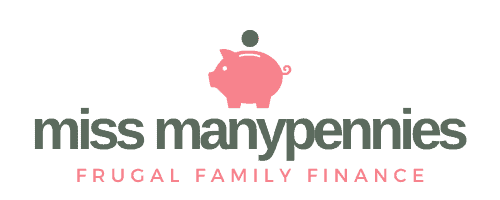Why it might be time to upgrade yourself from a savings account – (Part 2 – Bonds)
Posts contain affiliate links, see disclosure for more details.
This article is the second in a two-part investing for beginners series on Miss Manypennies. It was created by Simon from Financial Expert to outline two ways in which we can improve upon the tiny interest rates offered by savings accounts today.
We suggest that you begin at the first article here: Investing for beginners – Part 1.

Alternative 2: Short-dated corporate bond funds
Rate of return: 1.5% – 5%
Risk: Low to Medium, depending on the credit rating of the companies.
What are corporate bonds?
Bonds are loans made to large companies or governments. They are a common way for companies to raise finance.
Collective investment schemes and pension schemes buy the bonds. The borrower then uses the cash, pays a fixed interest rate on the bond and repays the original sum in full at the maturity date.
You can invest in bonds through collective investment schemes (aka ‘funds’) which hold a diversified portfolio of bonds. To do this, you will need an online stockbroker or an investment account offered by your bank.
The appeal of corporate bonds is that they tend to pay a higher interest rate than a savings account. As well as interest, the value of your units in the fund may also increase in value.
A typical corporate bond fund interest yield is 3% per year. Whereas higher-risk corporate bond funds may pay up to 5%.
What types of bond funds are there?
Each bond fund tends to buy bonds of a specific niche so that investors clearly understand what they’re buying into. We will walk through several of the labels and categories that funds use to help you understand which types of funds offer an incremental step up from a bank account.
Corporate bonds versus government bonds
Funds will usually specialise in either corporate or government bonds. Government bonds, issued in a country’s own currency, are ‘risk-free’ in the sense that a country can always print more currency to make repayments. This means that defaults on government bonds are very rare, and therefore these are regarded as low risk, low return investments.
One problem for us is that they are so low risk that their interest yield s usually lower than a bank account. Therefore you’d be better off in a savings account.
Corporate bonds are higher risk because corporate bankruptcy is more common. However, the quality of companies can vary enormously. Some companies have a AAA or ‘triple-A’ credit rating, which indicates that they are the strongest borrowers on the planet. Some of these companies, such as Apple and Disney, have better credit ratings than some governments.
On the other hand, companies which are in financial difficulty have credit ratings so low that their bonds are referred to as ‘junk’ bonds.
Developed markets versus emerging markets
An indication of risk can also be found by looking at the geographical location of the bond issuers.
Companies in developed economies such as the UK, Germany, Japan and the USA tend to have lower risks than their counterparts in emerging economies such as China, Brazil and Indonesia, because of the political instability, corruption issues or weaker rule of law generally found in emerging economies.
Emerging market bond funds typically offer the highest yields of any on the market, but these carry significant risk. In particular, the fluctuating value of their currencies means that in sterling terms, the value of your investments will also fluctuate simply because of the exchange rate.
Therefore for an incremental step-up from a savings account, we recommend you do not invest in emerging market bond funds.
Distributing funds versus accumulating funds
All funds will either be labelled as a ‘distributing / income’ fund or an ‘accumulation’ fund. This describes how the fund deals with any interest payments it receives.
Distributing funds pay out the interest received as a dividend to investors. This means that from your perspective, the fund will feel more like a savings account – i.e. it pays a cash rate of return each quarter.
Accumulating funds use the interest to buy more bonds instead, and grow the value of each fund unit you own.
Neither fund type has a decisive advantage over the other.
Distributing funds are helpful for retirees who use investment income to fund their expenditure. Accumulating funds are convenient for long term investors, as they automatically put interest back to work without the investor needing to take action.
Because distributing funds more closely mirror the experience of a bank account, I recommend that beginners start with these.
Short-dated versus long-dated bonds – a warning
Funds which buy bonds that mature in the distant future (known as ‘long-dated bonds’) are relatively high-risk investments. The price of units in such funds have similar volatility to stocks and shares!
Their value will react dramatically to any changes in official interest rates.
Why is this the case? The full explanation is complicated, but the simplest explanation is as follows:
- Bondholders are locked into a particular rate of return, based on the actual price they paid for the bond, and the sum it will payout at maturity.
- Changes to interest rates on other investments during the holding period will leave a bondholder either a winner or a loser.
- If interest rates rise while a bondholder is locked into a particular rate of return, they have lost out by being stuck to a fixed interest rate which now looks uncompetitive.
- If the bond is short-term, the bondholder only misses out for a few months, after which the investor can reinvest the proceeds in more attractive investments.
- If however, the bond matures in 30 years, the bondholder will miss out on the interest difference for thirty years.
Therefore the gain or loss that results from a change in interest rates is far more extreme for long-dated bonds.
For this reason, only short-dated or short term bond funds are appropriate as an incremental step up from a savings account.
What type of bond fund would be an upgrade from a savings account?
To tie together these different concepts, the following list of bond funds meet each of our preferred characteristics. You may wish to perform further research on these funds, and others that are similar:
- Short Dated Corporate Bond Fund – M&G Investments (2% yield)
- Short Dated Corporate Bond GBP Income – Fidelity (3.8% yield)
- Sterling Short-Dated Corporate Bond Fund – Threadneedle (1.9% yield)
These are corporate, include companies from developed markets, distribute their income and invest only in short-dated bonds.
An investment split equally across these funds should yield roughly 2.7% per year, comfortably exceeding inflation.
About the author: Simon contributes to Financial-Expert.co.uk, an educational resource for investors at the beginning of their investing journey. Articles on the site often take the form of ‘how to’ guides, such as how to invest in property and how to build a basic investment portfolio.
You might also like:
What are the best investment platforms? >>
Why you need an emergency fund (and how to build one) >>
How much could you save by overpaying your mortgage? >>
Pin it!







